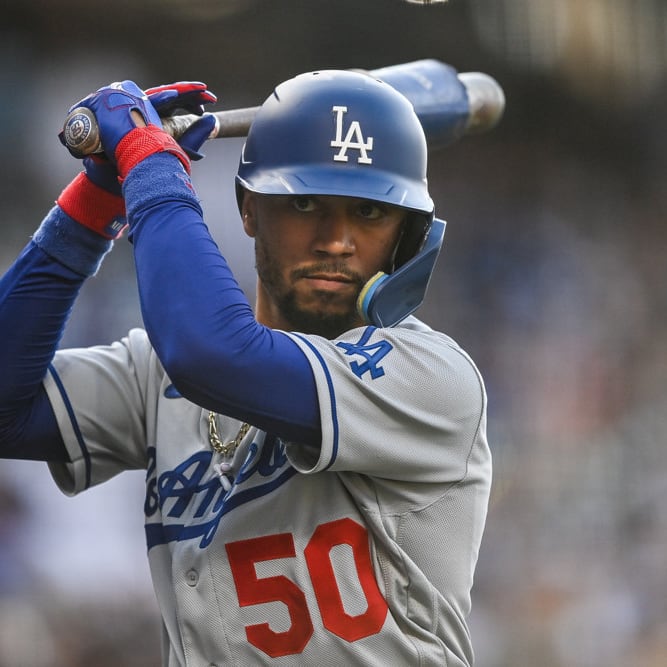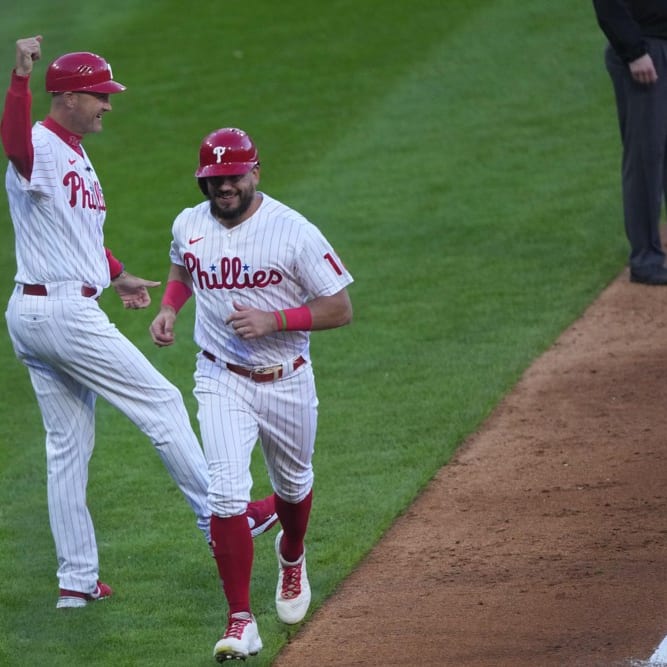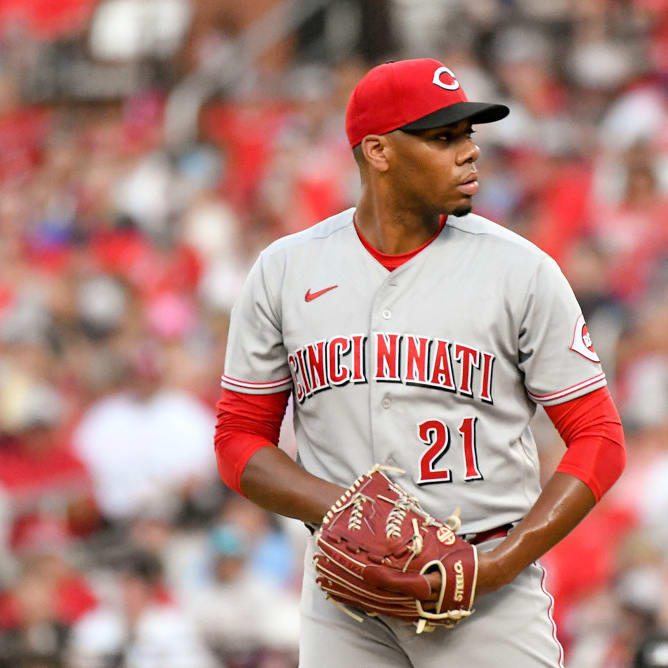This article is part of our Collette Calls series.
To review the premise of this 2020 series, please review the opening of the first installment of this year's series. To review the 2019 NL Bold Predictions, click here.
Chicago
Ian Happ is a top-250 player. Happ is ranked 342nd in NFBC drafts with an ADP of 347 and a range from 300 to 430. It was not that long ago we all loved this guy, but his current ADP feels like a heavy dose of recency bias. Yes, the contact rate was abysmal in 2018, and he spent a lot of time in Triple-A last year because there was not an open roster spot for him and he frankly wasn't doing much in the PCL even with the new baseball.
Eleven homers in 156 plate appearances, even with the 2019 conditions, is impressive. He did it on the back of a 26 percent HR/FB%, which is nearly identical to his 25 percent rate from that 2017 season. This time around, he did it with a lower pull percentage and used all parts of the field. He also did this while reducing his strikeout rate from 36 to 25 percent. His swinging strike rate is still bad at 15 percent, but he has reduced his two-strike strikeout percentage from a lost-cause 58 percent to 40 percent last season.
If 2018 taught him anything, it was that he was too passive in those situations and looked to walk, which he did 15 percent of the time, but the price
To review the premise of this 2020 series, please review the opening of the first installment of this year's series. To review the 2019 NL Bold Predictions, click here.
Chicago
Ian Happ is a top-250 player. Happ is ranked 342nd in NFBC drafts with an ADP of 347 and a range from 300 to 430. It was not that long ago we all loved this guy, but his current ADP feels like a heavy dose of recency bias. Yes, the contact rate was abysmal in 2018, and he spent a lot of time in Triple-A last year because there was not an open roster spot for him and he frankly wasn't doing much in the PCL even with the new baseball.
Eleven homers in 156 plate appearances, even with the 2019 conditions, is impressive. He did it on the back of a 26 percent HR/FB%, which is nearly identical to his 25 percent rate from that 2017 season. This time around, he did it with a lower pull percentage and used all parts of the field. He also did this while reducing his strikeout rate from 36 to 25 percent. His swinging strike rate is still bad at 15 percent, but he has reduced his two-strike strikeout percentage from a lost-cause 58 percent to 40 percent last season.
If 2018 taught him anything, it was that he was too passive in those situations and looked to walk, which he did 15 percent of the time, but the price he paid was taking called strikes. Thirty-one percent of Happ's strikeouts in the 2018 season were him standing at the plate taking a called third strike, which was a jump from his 22 percent effort in his rookie season. Last season, 23 percent of Happ's strikeouts came as a result of a called third strike, putting him back to what we liked in 2017. His expected stats in 2019 were better than what he did in 2017, and as a switch-hitter, he is better from the stronger side of the platoon. He is a steal as the 96 outfielder off the board given his upside.
Jharel Cotton earns $5 in NL-Only leagues. This is a forgotten man as he is the 309th pitcher off the board with an ADP of 709 and a range from 574 to 748. He has gone undrafted in 30 percent of NFBC leagues to date, and with good reason. Cotton has not thrown a major league pitch the last two seasons, and pitched fewer than 30 innings in the minor leagues last season while rehabbing in the Oakland organization around a hamstring injury, which required surgery in the middle of the season.
The story with Cotton is always going to be the changeup, as it is a special pitch when it's right, and makes everything else look better. Even last year in his struggles in Triple-A, he struck out 24 batters in 18.2 innings. Cotton does not have a clear path to the rotation, but he does not need one to earn $5 in NL formats. He can work as a middle reliever and earn that if everything, and I mean everything, breaks the right way for him. There is opportunity for him in the pen to get work in during medium-leverage situations and vulture some wins, get his strikeouts and potentially pitch to better ratios with limited exposure to hitters. You do not need to do anything more than utilize a reserve roster spot in a deep NL format to see if Cotton can regain some of his pre-injury form.
Cincinnati
Josh VanMeter is a top-350 player. He is the 111th outfielder off the board with an ADP of 404 and a range from 288 to 591. VanMeter has middle-of-the-pack sprint speed by StatCast, yet went 9 of 12 in the stolen base department with the Reds last year and 17 of 23 overall between the majors and Triple-A. He also chipped in 22 home runs, which was easily a career high in a career that dates to 2013 when the Padres drafted him out of high school.
He has not shown any ability to hit lefty pitching at the big-league level, but his body of work between Triple-A and the majors last season produced a .286/.378/.597 batting line in 91 plate appearances, which was a step up from an ugly .202/.274/.308 line in 118 plate appearances against lefties in 2018 between Double-A and Triple-A. Splits take awhile to stabilize, so VanMeter's ceiling may be limited to him making the most out of his at bats against right-handed pitching.
If you play around with BaseballSavant's Player Similarity feature, some interesting names such as Brett Gardner and Joc Pederson show up. Pederson's career would be the best-case example for VanMeter, and Pederson's 2019 season would be a 99.9th percentile probable outcome, but this is a skillset that can make the most of an opportunity coming at a nice discount.
Michael Lorenzen hits more home runs than he allows. Everyone knows I love Cincinnati pitching under the tutelage of Derek Johnson. I've long been a fan of the man, and the work he did first at Vanderbilt and then throughout the NL Central. He delivered for me once against last year when I was all-in on Sonny Gray, which paid off nicely. This year, it would be easy to say Luis Castillo could do better, but I want to have fun. Lorenzen is the 148th pitcher off the board with a 389 ADP and a range from 307 to 504. There's profit to be found in that volatility alone, because he took a significant step forward last season under Johnson.
Lorenzen will work as a two-way player for the club again this year. Last season, he allowed nine home runs in 83.1 innings, while hitting one home run in 53 plate appearances. He has hit seven home runs in 145 lifetime plate appearances, four of which came in the 2018 season. However, this prediction banks on his pitching being good enough to lower his home run rate to give him a good chance. He has allowed six or nine home runs in each of the previous three seasons, but was one of the toughest pitchers to square up in baseball last year with 97th percentile barrel rate and exit velocity.
Heavier use of the changeup last season nearly doubled his swinging-strike rate and surged his strikeout rate, but led to more flyballs, hence the homers. It was his first year using the pitch as frequently as he did, so that plus the 2019 baseball goofiness are to blame. Put me down for five homers hit and four homers allowed this year.
Milwaukee
Omar Narvaez will not be a top-20 catcher. He had a career year in his first season as the primary catcher for Seattle. The batting average and on-base percentage has always been there, but the power showed up for the first time in his career as he nearly doubled his career home run total in 2019. That power surge happened despite Narvaez's average exit velocity being in the bottom 10th percentile league wide.
His home run to flyball ratio was a career high but not too much higher than what he did in 2018. However, the 41 percent flyball rate last season was easily a career high, as was his 18 percent launch angle. The increased rate in flyballs is one way to make the most out of bad exit velocity, but the expected statistics are banking against another 20-plus homer season for Narvaez.
| Season | Pitches | Exit Velo | Launch Angle | BA | xBA | SLG | xSLG | wOBA | xwOBA |
|---|---|---|---|---|---|---|---|---|---|
| 2016 | 460 | 85 | 14 | .267 | .252 | .337 | .328 | .304 | .305 |
| 2017 | 1201 | 83 | 11 | .277 | .270 | .340 | .373 | .321 | .322 |
| 2018 | 1311 | 85 | 13 | .275 | .256 | .429 | .373 | .348 | .322 |
| 2019 | 1979 | 85 | 18 | .278 | .254 | .460 | .422 | .345 | .324 |
2019 was the second consecutive season Narvaez has outperformed his expected stats across the board. Asking anyone to do that three consecutive season is asking a lot. Our projections have him losing eight homers, but maintaining his batting average. Looking at what he has done the last four seasons for average, the projections are realistic. The expected stats are trending the other direction, and if that catches up with him, a catcher with 14 homers and a .255 average isn't very special. He is the 12th catcher off the board with an ADP of 225 and a range from 173 to 268. He would need to fall 60 spots to drop out of the top 20 at catcher, and after what we saw at the position last season, the position has some volatility to it.
Corbin Burnes is a top-125 pitcher. He is the 183rd pitcher off the board in drafts with an ADP of 453, and a range from 382 to 585. Burnes was a hot commodity last offseason after he flashed his potential late in 2018. Last season, he still threw hard, struck out 70 in 49 innings, but nearly allowed as many homers (17) as he did walks (20). He was eventually shut down with a sore shoulder and didn't re-surface until late September.
The scouting report grades Burnes with four average to above-average pitches and above-average command, though admittedly, they were rarely on display in 2019. He made four starts at the beginning of the season and allowed 11 homers over those four starts with multiple homers in each outing. He then went to the pen, and did decently until being obliterated by the Braves who hung a seven spot on him and hit three more homers in 0.2 innings. Burnes only pitched 21.2 innings after that, but in that time, he had a 24 percent K-BB% while striking out 31 percent of the hitters he faced. He also had a .431 BABIP, a 1.62 WHIP and a 7.06 ERA. It's honestly unfathomable how someone with his stuff could struggle so badly around all of the strikeouts.
There are many things to run away from, but there are also a few things that are intriguing.
| Name | Z-Contact% | Contact% | Zone% | F-Strike% | SwStr% | BABIP | K% |
|---|---|---|---|---|---|---|---|
| Corbin Burnes | 80% | 65% | 43% | 61% | 17% | 0.414 | 30% |
| Edwin Diaz | 72% | 65% | 43% | 63% | 18% | 0.377 | 39% |
| Nick Anderson | 73% | 64% | 48% | 67% | 20% | 0.349 | 42% |
| Blake Snell | 80% | 64% | 40% | 68% | 18% | 0.343 | 33% |
| Ken Giles | 78% | 63% | 42% | 60% | 19% | 0.301 | 40% |
| Tommy Kahnle | 74% | 65% | 43% | 62% | 18% | 0.279 | 36% |
| Hector Neris | 75% | 64% | 37% | 60% | 18% | 0.240 | 32% |
| Josh Hader | 65% | 61% | 47% | 63% | 23% | 0.232 | 48% |
| Robert Stephenson | 79% | 62% | 41% | 63% | 19% | 0.230 | 31% |
If you are in on an Edwin Diaz rebound, you need to be in on a Burnes bounceback. Are you not at least a bit surprised that Burnes and Blake Snell had similar contact rates in the zone, similar overall contact rates, and even similar strikeout rates? The difference between Burnes and Robert Stephenson is one guy was crushed by the BABIP luck dragons while the other was extremely fortunate. There is also this:
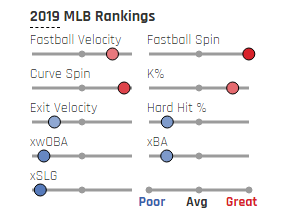
Frankly, the upside in this profile is too intriguing to ignore. He has the pieces to have a breakout season, as the stuff is there, but the results are lagging behind.
Pittsburgh
Josh Bell is a top-50 player. His ADP is 90 with a range from 78 to 110, coming off a career year. His season ended a few weeks early due to a serious groin injury, but it feels like he is being drafted as 2019 was peak rather than a step up in his progression.
| Season | Batted Balls | Barrel% | Exit Velo | Launch Angle | BA | xBA | SLG | xSLG | wOBA | xwOBA | Hard Hit% |
|---|---|---|---|---|---|---|---|---|---|---|---|
| 2017 | 435 | 7% | 88 | 9 | .255 | .265 | .466 | .441 | .338 | .340 | 34% |
| 2018 | 402 | 7% | 90 | 9 | .261 | .260 | .411 | .420 | .336 | .340 | 39% |
| 2019 | 416 | 13% | 92 | 13 | .277 | .283 | .569 | .556 | .379 | .381 | 47% |
The expected stats validate the production he put up last year. He hit the ball harder, higher and further last year. His average batted ball distance progressed from 155 feet to 160 feet to 186 feet from 2017 to 2019. Those numbers, when isolated to his line drives and flyballs, went from 289 to 291 to 312 feet the last three seasons. We saw a different Josh Bell last season, and even within the season. Bell had a wrist injury in late July after a collision at first base covering a play, but only missed a day. However, if you split his numbers at that moment, we see Bell hit .287/.368/.597 with 27 homers before the injury with a .388 wOBA, but went onto hit .250/.365/.493 with 10 homers and a .352 wOBA after that injury. Factor that in plus the shortened September due to his groin injury, and he could have been a 40-homer, 130-RBI player.
The concern would be that Bell has a nice group of tablesetters in front of him with Bryan Reynolds, Starling Marte and Gregory Polanco, but the lineup behind him isn't exactly murderer's row. Pitchers could attempt to pitch around Bell and limit his RBI opportunities this year and instead deal with Colin Moran. Bell drove in 116 runs last year with Polanco playing just 28 games in the top two spots of the lineup, and Adam Frazier serving as the primary leadoff hitter. When healthy, the top half of the Pittsburgh lineup should be stronger and I believe Bell has a step forward to take in 2020 rather than a step backward.
Mitch Keller is a top-60 pitcher. He is 89th off the board with an ADP of 227 and a range from 156 to 287. Let everyone else look at Mitch Keller's major league stats from 2019 and laugh when you pick him up later in the 2020 drafts. Those numbers were indeed ugly, but he pitched well in Triple-A, and StatCast said Keller was in the top 20th percentile for fastball velocity, fastball spin rate, curveball spin rate and strikeout rate. Simply put, his stuff is much better than what the final results indicate. There was a 78-point differential from his actual weighted on base average to his expected weighted on base average last season as well.
Like Corbin Burnes, the StatCast profile shows the stuff he has which has not yet translated into the results that stuff is capable of.
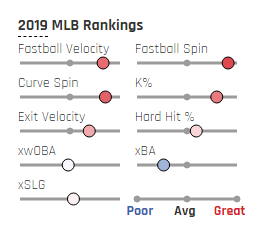
Keller's fastball is to blame for his 7.12 ERA as there was a 212-point difference between the expected weight on base average on contact (xw0BAc) of .421 and his actual w0BA on contact (w0BAc) of .633! When your fastball has a .591 BABIP, things will not work well for you. Simple regression make him a better pitcher, but his fastball could take more than just a simple step back to the mean this year.
St. Louis
Tommy Edman finishes outside the top 175. Edman is the 130th player off the board with an ADP of 128 and a range from 101 to 163. Edman had a strong rookie debut with a .304/.350/.500 triple-slash line finishing with double-digit homers and steals, and nearly pulling off a 20-20 season between Triple-A and the big leagues last year.
Edman's expected stats show a batting average 17 points below his actual average and a slugging percentage 59 points below is actual slugging number. Edman's speed (97th percentile sprint speed) is going to turn some outs into hits, but his aggressive approach at the plate that leads to low walks and low (for this era) strikeouts, that puts a lot of his fortune into how the ball behaves once it leaves his bat.
This skill profile looks primed for the dreaded sophomore slump, and as it were, he is slotted to hit near the bottom of the lineup. Those spots in the lineup are usually a slump away from giving someone else a chance, and Tyler O'Neill would love another chance to show he can actually make contact at the major league level. The lack of track record is what scares me here most. I would rather take the chance with Nick Madrigal, who is going 130 spots later in drafts.
Giovanny Gallegos is a top-60 pitcher and leads the team in saves. Carlos Martinez is the closer on paper but has already said he wants to be a starter. That is not a very wise strategy for a guy who dealt with shoulder fatigue last year in camp and had minor shoulder surgery to end the season.
Gallegos nearly doubled his swinging strike rate last year from 8.8 percent in 2018 to 16.3 percent last year without the addition of a new pitch. Gallegos is all fastball and slider, and he has a lot of run on his fastball and drop on his slider. He doesn't blow batters away with the fastball, but lives in the strike zone and pairs up the pitches extremely well. He does not have the splits issues that most righties with Gallegos's two-pitch combo has, and he could take the role and hold it all season. His ADP is 210 and he's the 81st pitcher off the board with a range from 180 to 290. Martinez sits at 193 as the 75th pitcher off the board so drafters are hedging their bets.
Gallegos may not have the typical closer fastball, but he has closer skills and just needs the opportunity that has thus far evaded him. The earlier you draft, the better the bargain he will be.







